Matador Network's Blog, page 577
October 8, 2021
Despite the fiery volcano and roaring rapids, Pucón, Chile, is totally chill

Nearly 500 miles south of the Chilean capital Santiago lies the Lake District town of Pucón. Dramatic Andean peaks abound here, the most notable among them being the Volcán Villarrica, an active volcano that seems both to guard over Pucón and threaten it. In front of Pucón lies a lake of the same name, the Lago Villarrica. Its tranquility belies not only the dangers of one of Chile’s most active volcanoes but of the raging water which pours into it from the Trancura River. While the lower part of the Trancura offers easy-to-navigate rapids suitable for families or those seeking a more sedate experience, the upper river is a bit more… splashy.
River rafting in Pucón, Chile
Photo: Kayak Pucon/Facebook
For anyone like me seeking to infuse some adrenaline into their Chile travel experience, the good news is that Pucón is full of operators offering rafting trips on Trancura’s speedier stretches. This means that some excellent prices can be had. Sierra Nevada Aventura was my operator of choice and transported me, some other intrepid tourists, and a few sturdy inflatable rafts to the wilder upper part of the river.
I wanted splashy, and splashy I got. This part of the Trancura is far from calm; having rafted on rivers worldwide, I was pleased to see that this one had some fun Grade IV rapids. This meant that there were huge waves, stomach-churning drops, and a fair chance of falling out. But, as ever, this was a very controlled, relatively safe adventure and we all managed to stay in the boat even when plunging down a 10-foot waterfall.
Pucón lies in the western foothills of the glacier-capped Andes Mountains, the range of volcanoes that stretch across South America and which divide Chile from Argentina. Fed by the snow from these volcanic peaks, the waters of the Trancura are certainly cool, even if less chilly than many other rivers I’ve rafted. Nevertheless, the first wave that crashed over the raft made me grateful for the wetsuit provided by the rafting company.
I also felt grateful for the fact that this glacier-fed river, free from pollution and very far from any big cities, was clean — given that many more crashing waves resulted in me getting mouthfuls of that cool water. But I only have myself to blame, having enthusiastically asked to sit at the front of the raft. Sitting further back tends to mean you don’t get a face full of river when traversing a rapid.
With all that aquatic excitement, it could be easy to ignore the scenery. But there are enough pauses in the drama to take in views of the forest, as well as of the 9,380-foot Villarrica volcano, pumping out smoke from its snowy summit in the distance. At one point it’s necessary to walk around one particularly rough set of rapids, which proves a good excuse to peer down at the white water rushing below.
If you get to the end of the rafting trip and feel you haven’t got wet enough, the guides tend to encourage you to jump overboard and float down the last dozen yards of smooth water. It’s a serene end to an action-packed couple of hours.
The best hiking in Pucón, starting with the volcano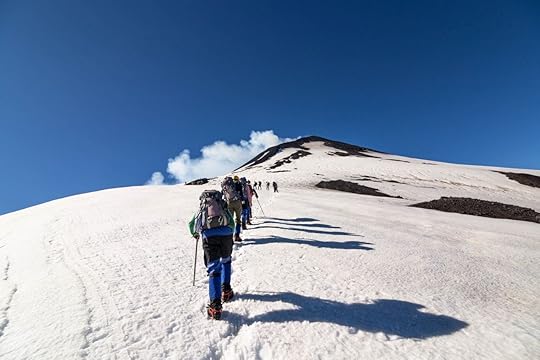
Photo: Macca Sherifi/Shutterstock
There are myriad ways to get your pulse racing around Pucón. In addition to all those operators in town offering rafting trips, many will also take you to Villarrica Volcano to hike up, or even ski down. You’ll be hiking over snow until you get near the caldera, where the heat of this active volcano has melted away the ice.
Those on tighter budgets can hop on a Caburgua bus to Huerquehue National Park, where there are walks with views for many miles around over forests, waterfalls, and that hard-to-miss, immense volcano. The bus deposits you at the office of the park’s CONAF, Chile’s non-profit National Forest Corporation; there, after you’ve paid a small sum to enter, you can begin your hike. Wide gravel paths wind steadily up through thick forests of deciduous and evergreen trees, until you arrive at the top, to find remote mountain lakes in which you can swim and cool off.
The trails in this park are few and well-marked, although I would recommend taking a map so that you can at least tell how far along a hike you are (and therefore not miss one of the few buses back to town). It’s hard to get lost, but there are no short hikes; you’ll want to at least bring some water with you. The park is also famed for its Araucaria trees, also known as monkey puzzle trees. Despite their playful appearance, these trees can live up to 3000 years.

Photo: NiarKrad/Shutterstock
Another good day-hike from Pucón, and another place to spot the famed Araucaria trees, is in the Cañi Nature Reserve. Reaching the mirador, or lookout point, at the over-5000-foot summit of this reserve is a challenge, but when you get to the top you’ll have a good view of four distant volcanoes, as well as dozens of lakes. Again, you’ll need to pay a small fee at the entrance, but, with public buses from Pucón to Huife stopping here, this is yet another low-cost and popular hiking option. With its Araucaria forest, and occasional sightings of puma and condor, it’s no surprise that Cañi is a world-renowned nature reserve.
As you may be beginning to realize, Pucón has a long list of activities to keep visitors occupied – certainly plenty to fill a couple of weeks there – and it’s a worthy rival to other top Chile travel destinations. As elsewhere in the country, horse riding is very popular here; and a particularly nice option is a 3.5-hour ride along rivers and through forests, stopping somewhere scenic for lunch. Mountain biking has become increasingly popular, with options to tear downhill, or to pedal around volcanoes and along dedicated trails. Afterwards, the Termas Geométricas hot springs will soothe any aches you may have sustained. And then, of course, there’s the lake.
During my time in Pucón I spent many hours swimming in the cool, perfectly clear water of Lake Villarrica, then drying off on the beach. This is most pleasant in the summer months of January and February, when temperatures reach around 70°F. From the beach you can also either take to the air parasailing or take to the water in a hired kayak or motorboat.
In those balmy summer months, an inflatable activity park floats just off the beach. This is perfect for families with children a little too young for arduous hikes or even the quieter, Grade III rapids of the Trancura River.
Where to eat in Pucón, including lemon meringue pie
Photo: Brester Irina/Shutterstock
The fast-paced action on the river, and leg-challenging trails of the parks, contrast with the serenity of Pucón itself. Not even the regular tests of the volcano warning alarm can disturb the easy nature of this town, which receives up to 10 hours of daily sunshine during its summer months of December to March.
There are plenty of hostels in town, including the well-rated, perfectly positioned Chili Kiwi Lakefront. The Villarrica Park Lake and Antumalal hotels are also on the lake, and considerably more luxurious. There is accommodation here to suit all budgets and tastes, but be sure to book well in advance of those busy summer months.
Perhaps my other favorite thing about Pucón, apart from the top-quality river rafting and hiking opportunities, is the prevalence of restaurants and cafes with on-the-street seating and serving a wide range of cuisines, including generous portions of lemon meringue pie. For some happy reason this is a popular dish in Chile, and the ones served in Pucón tower with delicious lemon curd and meringue. If you walk along Lincoyán, just off the main street of Bernardo O’Higgins, you’ll find a range of excellent cafes, including my favorite, Oma’s Café.
Full of Trancura water and pie, what better way to round off the perfect Pucón day than to wander back to that sublime beach, and watch wavelets gently hush against the black sand shore. At sunset, locals and travelers — most of them from Chile — come out to marvel at the colors of the sky reflected against the lake itself. And there, always keeping watch, is the hard-to-miss Villarrica volcano, the snows of which get bathed in the golden glow of day’s end. 
Everything you need to know to be a sustainable fashionista

When scouring reviews before buying outdoor gear, we often look for such qualities as waterproof, windproof, comfort, and product durability. This guide provides the information you need to add environmental impact to your quality standards for clothing purchases. This extraordinary summer, with an unprecedented heatwave in British Columbia, massive floods in Western Europe, and yet another destructive tropical storm in New York City urges us to empower ourselves to make better lifestyle choices, and sustainable clothing purchases are a great place to start.
The fashion industry is one of the highest polluters out there, not just with its excessive use of water and dyes that make their way into rivers and oceans, but also because its finished products, the clothes we love to buy, rarely have a long lifespan before they end up in a landfill.
If you’ve ever pondered “How can I be more ethical when shopping?” we’re here to help. We know navigating this tricky arena and avoiding the traps of both fast fashion and greenwashing can feel overwhelming, so we’ve broken down the different ethical and environmental issues you might want to consider and listed some of our favorite sustainable clothing companies that are doing great things.
How to reduce your wardrobeWhen to resell? When to donate? When to trash?How to repair your clothingHow to recycleHow to choose fabrics: natural v. syntheticWhy location, location, location is so importantHow to offset the damage of your clothing purchaseWhat is greenwashing in the fashion industry? And how to avoid itBefore considering some essential shopping guidelines, let us first repeat the mantra of the conscious consumer: reduce, reuse, repair, recycle.
Reduce: The most ethical item of clothing in your closet is the one you didn’t buy
Photo: tarin chiarakul/Shutterstock
An even simpler mantra to remind ourselves of is “buy less.” Before buying new, consider giving an existing garment another lease on life by shopping in thrift or consignment stores, organizing a clothing swap with some friends, checking out your local Buy Nothing group, or, despite the obvious dangers, shopping in your family’s closet.
Keeping an item of clothing in circulation for a few more years is one of the best things you can do for the environment. I like doing this especially for items I am either very likely to use frequently, such as cheap t-shirts I’ll wear to threads in a single season, or items that I might just wear a handful of times, such as a party dress.
A great alternative to adding preloved items to your wardrobe is maintaining a minimalist closet and supplementing it with rented clothing. Thanks to clothing rental subscription services, you can keep swapping out fresh looks while limiting your possessions — Rent the Runway now even ships your rented vacation wardrobe directly to your hotel. If you’re curious about taking minimalism and creative accessorizing to the next level, you might explore the versatility of a single dress and join the inspirational 100-Day-Challenge at Wool& that dares participants to wear the same dress for 100 straight days.
Reuse: When to resell? When to donate? When to trash?Parallel to the above question of when to buy runs the question of when to say goodbye to an item of clothing. Some items you no longer wear could make you some extra cash at a consignment store or online marketplace. But what about any other closet content?
Before you put your hand-me-downs in a donation bin, consider other options. Clothes in donation bins often end up in landfills either directly or after being dumped in the Global South. You are much better off directly contacting a local shelter or organization that works with newcomers, or donating clothes in good condition that you just don’t wear anymore to a local charity shop.
Buying from or donating to charity shops not only increases someone’s access to clothing and helps the environment; it also creates revenue for not-for-profit organizations. Interesting fact, many hardcore zero-wasters advocate for using old t-shirts and other items as rags instead of dropping them off at donation bins.
Repair: Patch up worn items or find someone who can
Photo: Natali Ximich/Shutterstock
If you’re not handy yourself and you can’t call on a creative friend with a sewing machine, you might find repair workshops in your neighborhood. Repair Café, for example, was born in The Netherlands in 2009 and has grown into a global network of local chapters that connects people with broken objects to those who can fix them in an effort to counter our throwaway culture. Most Repair Cafés are organized as recurring events, but if you’re lucky your area has a permanent repair shop like Remade in Glasgow, Scotland. Some clothing companies, like Patagonia, will also repair your items for free or a small fee. If your favorite pair of shoes needs a fix, you can probably find a cobbler somewhere nearby; trust me, telling your friends you have to pass by the cobbler will make you feel like you’re living in a Jane Austen novel.
Recycle: A new career for your old clothesAs with food packaging, reducing and reusing should be favored over recycling whenever possible since it always requires additional resources to transform one product into another. There are some great initiatives out there, however, such as MUD Jeans, a Dutch company where you can buy or rent a pair of recycled jeans. Their recycling process uses 92 percent less water than necessary for the creation of the average new pair of jeans. They have been turning heads in Europe to the point that they recently collaborated with IKEA to design a recycled denim cover for one of the Swedish furniture giant’s signature couches.
Other ways companies have tried to minimize waste is by using up as much fabric as possible. Christy Dawn, for example, makes dreamy dresses out of fabrics that remain unused by other companies.

Photo: Christy Dawn
Ace & Jig is another company creatively repurposing all leftover ends of their fabric by turning them into hairbands, scrunchies and entire garments out of patches.
How can I shop more ethically for clothes?How to choose fabrics: natural v. syntheticThis is probably one of the trickiest aspects of shopping for sustainable clothing. While it may sound cool to get a fleece made entirely from plastic bottles, the process to spin this item is actually quite resource-intensive. On top of that, every time you put this sweater in the wash, it will release microplastics that eventually end up in our waterways. While Patagonia has designed a washing bag to prevent this leakage, a natural fabric will be easier on the environment and your skin.
Even when looking at natural fabrics, we have to consider the production process. While cotton farming is notoriously water-intensive, organic cotton doesn’t add to that the use of pesticides that leach into the soil, making it always a better choice. Bamboo, on the other hand, grows exceedingly quickly and doesn’t require much water. Wool is great for its durability, but, often depending on the scale of production, may be more or less ethically sourced. And, of course, if you are vegan, wool is always unethically sourced because it is an animal product.
Canadian outdoor clothing company ecologyst has recently started using camel hair, which is harvested through natural shedding rather than shearing the animals.

Photo: ecologyst
Another fabric that has been turning heads because of its sustainable traits is hemp. California-based company Jungmaven offers an entire hemp collection, while Calgary-based Seed produces versatile hemp pants for natural movement.

Photo: jungmaven
Why location, location, location is so importantConsidering the location where your package is shipping from or where its contents were manufactured is crucial to the environmental cost of your purchase. Ideally, we walk to a store where we buy a shirt that was designed and sewn in the back of the building from fabric that was woven there, the prime material of which was grown in the backyard of the store. You get the idea.
This is an uncommon scenario in the 21st century, but we should do whatever we can to shorten the distance a garment travels. One of the reasons I invested 1,000CAD of my hard-earned cash in ecologyst, for example, was their commitment to produce in North America. In fact, in their new Victoria BC headquarters, you can shop, watch a seamstress make your clothes, and chat with the CEO. All that’s missing to complete my fantasy is a field out back to grow hemp and graze sheep.

Photo: ecologyst
Shortening the travel distance of an item of sustainable clothing and its composing parts also increases the transparency of the labor practices during the production process.
When items are handmade by the person selling them, the cost more likely reflects the true cost of production. For example, when buying what may seem like an expensive sweater from Olann, a one-woman operation that sells handmade wool sweaters, the price reflects not only the high quality of the ethically sourced wool, it also reflects the true cost of creation — a liveable wage for the knitter.

Photo: Olann
How to offset the damage of your clothing purchaseWhile you may have heard of companies that allow you to plant trees to offset the damage of your air travel, similar initiatives exist in the clothing industry. For example, for each garment you purchase, the company tentree will plant — you guessed it — ten trees; while United by Blue compensates for the environmental cost of consumption by removing one pound of trash from the ocean and waterways for each purchase. Another good resource is TreeClicks, an app that plants trees when you shop online using their interface.
What is greenwashing in the fashion industry?Because many consumers care about the environment and are worried about the impact of the fashion industry on climate change, ethical clothing has become a billion dollar business. Unfortunately, this has led to some abuses and many greenwashing initiatives — using environmentalism as a marketing strategy to increase profits without actually benefiting the environment. They might highlight one small thing they are doing for the environment to stop you from looking too closely at the rest of their activities.
How to avoid greenwashing: Strive for improvement, not perfectionAs consumers, we hold the all-important power of the purse strings. With rising concerns about greenwashing, the conscious consumer can feel at a loss as to which companies to trust and which factors to prioritize. In the end, much like voting in an election, you can’t always just rely on what the candidates are saying; you’ll have to do some of your own research and know that the best option for the environment is always to buy nothing.
Anne-Marie Bonneau, the woman behind Zero Waste Chef — the book, the blog, and the Instagram account, where she demonstrates how to live plastic-free and reduce food waste — says: “We don’t need a handful of people doing zero waste perfectly. We need millions of people doing it imperfectly.”
The same is true for sustainable clothing consumption. It can be daunting to change your habits. Start small; change one thing. If everyone swapped out just one bad consumer choice for a better one, collectively, we would be making a lot of progress. 
October 7, 2021
How a love for wine can inspire you to pack up and move around the world

Rachel Signer’s life in New York was far from what she had imagined it would be. When she wasn’t waitressing or selling wine at a local wine store in Brooklyn, she was hustling as an under-appreciated freelance writer. She was discontent and realized there was more she craved.
She moved from her small New York City apartment under the freeway to Paris. Signer’s love for the sparkling natural wine pétillant-naturel (or pét-nat for short), coupled with her frustrations and lack of romantic prospects in New York, encouraged her decision. The travel didn’t stop there.
From Paris, Signer began a journey of self-discovery that led her around the world to study all aspects of wine in countries like the Republic of Georgia, Slovenia, France, Sardinia, and Australia, among many others. Throughout her travels, she sampled hundreds of global wines and committed to learning about the wine producers in the industry. She eventually decided to make her own wine. Along the way, she found a partner who not only shared with her a mutual appreciation for wine-making, but a desire to start a life and family together.
Signer documents her life story and the lessons she learns in her upcoming book You Had Me at Pét-Nat, available on October 19. The book is an inspiration to chase your passions — even if your passion happens to be different than traveling the world studying wine.
“If you feel stuck or someplace is calling to you,” Signer says, “you really owe it to yourself to get out there. You’ll never have enough money saved up, you might not have exactly the right visa at the moment, but if you wait too long, you’ll never do it.”
This interview has been lightly edited for length and clarity.
You’re an avid traveller who has spent a lot of time in the States, Europe, and Australia, among other places. What’s your favorite destination and what did it teach you about winemaking?Unquestionably, Paris has always been (and still is) my spiritual home for natural wine. Parisians were early champions of natural wine, giving it a home in bistros such as Le Baratin that served rustic, simple, but exceptionally flavorful dishes alongside wines made in the same spirit.
Parisians have, in general, a very special attitude toward wine in that it is a necessary pleasure and integral part of the meal. Natural wine culture in Paris is surprisingly unpretentious. The way restaurants offer you wine is to essentially expect that you trust them — they will show you a few bottles and ask you to choose quickly without saying more than “this is a beautiful light red from the Jura.”
Paris taught me a lot about how to consume wine. In terms of winemaking, I’d say that I learned a lot visiting the Republic of Georgia, where I saw how very little technology and minimalistic vineyard management could produce extraordinary natural wines.
Speaking of Paris, you witnessed first hand the difficulties of picking your own fruit in France. What did you learn through this experience?When you look at a vineyard, you see a piece of land with some leafy trunks growing in rows. To the people who make wine from that land, it represents a stunning amount of year-round work: hand-weeding or maybe driving a tractor through the rows, planting green manure, pruning in winter and possibly also in summer, canopy management — and that’s not even to mention the sprays to protect against mold and mildew. When I worked harvest with Domaine Mosse that I discuss in chapter 3 of my book, I came to understand how complicated and chaotic vineyard management can be for today’s natural winemakers who don’t necessarily have one large estate next to their house, but rather several plots in different locations.
You found the love of your life, and now husband, Anton van Klopper on a trip to Georgia. Do you have any advice for travelers who are looking for love during their travels?It’s exciting to encounter love while you’re abroad because you’re not really thinking about that since you’re absorbed in the experience and culture around you. That’s an excellent way to meet someone because you don’t have the trappings of routine “dating” as you would at home. For me, it was challenging to navigate communicating over a great distance. I would suggest setting boundaries so the other person understands when you need space to live in the present when you’re not in the same part of the world.
You’re now in Australia with a husband and child, and you’re making your own natural wine and publishing your own magazine, Pipette. Is this all you dreamed about in terms of your career and personal aspirations?Having a farm and a winery within reach of the house means that we’re never not working. Usually, I answer emails for Pipette magazine while having coffee, and then I’m doing some winery or farm work in the morning, and then magazine work like editing or layout design again in the afternoon. My goal is to spend more time with our daughter and work less, but there’s always so much to do!
We just started bottling the 2021 wines, and next is labelling them and packing them for shipment. Then we have about two months before it’s time to get ready for harvest again. This year we’ve been improving and diversifying our farm, which features about 6,000 young vines planted over the past two years, and a veggie patch that supplies my husband’s restaurant. We’ve planted avocado trees, more olive trees for oil production, blueberries, and many apple and stonefruit trees. I’ve been planting lavender, yarrow, and tansy around the vineyards.
My hands are leathered, with all sorts of nicks, and my arm is always sore from working the hand hoe. But we enjoy natural wine and organic food so much, and our daughter loves being in the winery and the veggie patch, and there are so many beautiful moments. It’s just hard with the pandemic — we don’t get a break to travel, so we work and work!
In your book, you discuss the connection you feel to Paris, especially because your best friend and “sister” Gaba lives there. What drew you to Paris? Is there any chance of you returning there?I would have been back to Paris at least twice now if not for the pandemic, since Australia has a strict, ongoing border closure. I really miss France, especially Paris but also other regions, and I miss Gaba. Sometimes I dream in French. Gaba and I also spent time traveling in Italy and had plans to do that. All of that’s on hold now. But I don’t think I’ll live in a city again in the near future now that winemaking is so central to my and my husband’s lives. We are presently researching the possibility of having a very small agriturismo operation in Italy, perhaps with a tiny vineyard, but nothing requiring too much equipment so that we can spend more time with friends and family in the Northern Hemisphere.
The world of wine is complex. What are your suggestions for someone trying to enter this industry? Do you think there’s a “wine capital” somewhere that they must tap into?It used to be that New York was the wine capital of the States, but natural wine in particular is flourishing all over the country! Pipette has stockists in small towns I’d never even heard of.
I do suggest finding time to visit New York occasionally for events and tastings because you can meet importers (many of whom are based there) and establish a relationship with them, which really helps for buying wine. You can also meet traveling winemakers once that is happening again. It’s a good idea to attend wine fairs such as RAW so you can taste widely and meet the producers.
But there are lots of other places where natural wine is becoming very exciting, such as Baltimore, Portland, Oregon, Austin, Texas, and Los Angeles. I definitely recommend offering yourself as a harvest intern for a few weeks, but be prepared to work really hard on very little sleep.
You spent 7 years in Brooklyn. Do you think the wine scene in New York has changed since you left?From what I can tell, it was blossoming beautifully with many new and exciting wine programs until the pandemic hit. As we know, it hit New York particularly badly at the start. Fortunately, New York is strong and I’m sure the wine scene will eventually bounce back.
You can find Black-owned businesses wherever you are with the help of this app

more travelers are looking to better understand where their travel dollars are going, and apps are great resources to find minority-owned companies are on the rise. Enter the Blapp app, geared to travelers who want to discover Black-owned businesses when traveling, or in their own town.
Founder, Jon Laster, got the idea while traveling across the country for comedy tours. He wanted to seek out Black-owned businesses but had trouble identifying them through regular online searches.
Blapp is an e-commerce marketplace app that highlights black-owned businesses by location. According to Lonely Planet, Blapp works through its web-scraping technology to provide a consolidated and current repository of information from across the internet.
The information is then filtered in the app and organized into categories so users can easily navigate a city and find Black-owned restaurants, clothing stores, nail salons, hair salons, etc.
Blapp will give users a plethora of options to choose from. If a user is looking for places in New York, eateries like Amarachi located in Brooklyn Heights that serves African cuisines will be shown. For the sweet tooth, there is Happy Zoe Vegan Bakery that offers sweet vegan options. Or, shopping options like Brother Vellies, which sells handcrafted African-influenced fashion. 
5 of the best American-themed restaurants abroad, from the kitschy to the authentic

There’s a common line of thinking that you shouldn’t eat American food or go to American-themed restaurants abroad. Well, people who follow that clearly don’t know what it’s like to go two weeks without classic diner fare, specialty hot dogs, the very specific styles of barbecue in the United States, or American pie.
Admittedly, American-themed restaurants can be hit or miss. Some are gimmicky, with photos of ex-presidents lining the walls and American flag toothpicks in every sandwich. Others go for a more retro Americana theme, to make you feel like you’ve stepped onto the set of Happy Days. Yet there are some American restaurants around the world that nail it and can rival what you’d find stateside.
Whether you’re there for the kitschy decor or a meal that reminds you of your local diner, these are some of the best places to get a taste of home while abroad.
Jones – K’s Original American Diner in Munich
Photo: Indiana Cafe/Facebook
I had been in Munich for five days. My meals were pretty much a revolving door of bratwurst, knödel, schnitzel, Spätzle, and chanterelle mushrooms, and as much as I enjoyed the heavy German fare, I needed a change. That’s when I saw the glowing sign of Jones – K’s Original American Diner around the corner from my hotel, and stumbled in like a parched wanderer in the desert. The diner’s 50s theme didn’t feel gimmicky, but instead true to how retro diners in the US actually look. There was an old jukebox, Rt. 66 paraphernalia on the walls, photos of pinup girls, and those red and white booths. Perhaps most importantly, the menu was extensive and had all the classics, including mozzarella sticks, philly cheesesteak, and apple pie. I went back two nights in a row, and I’m not ashamed to admit it.
Indiana Cafe in Paris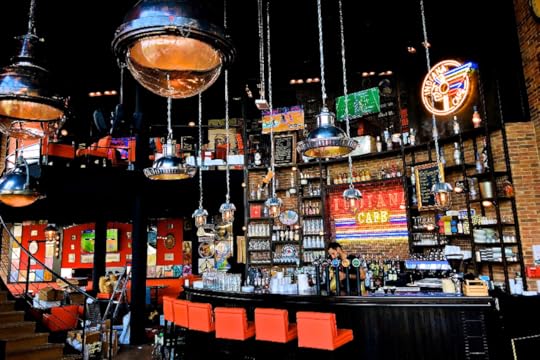
Photo: Indiana Cafe/Facebook
By , fewer than 50 percent of Americans can name all 50 states. So it’d be unreasonable to expect a Parisian to do so, let alone get the style of food from each state correct. Geographic confusion is really the only explanation for this Indiana-themed Paris establishment that serves primarily Tex-Mex food. As you’re probably aware, Indiana is not known for its Tex-Mex. Indiana Cafe, however, is. The restaurant specializes in fajitas, tacos, burritos, and nachos, Despite the head-scratching menu, the restaurant’s aesthetic, particularly the red-bricked bar, is undeniably American, and you wouldn’t regret coming here for a reminder of home.
The Yellow Rose of Texas in Iquitos, Peru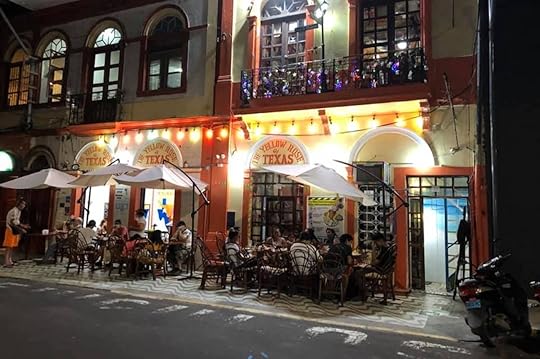
Photo: Yellow Rose of Texas/Facebook
There seems to be a common Texas theme when it comes to American restaurants abroad. The Yellow Rose of Texas in Iquitos, Peru, leans into all things Lone Star State with its Texas-themed restaurant. Here, you’ll find walls covered in posters and jerseys of Texas sports teams, hostesses wearing University of Texas attire, and a “hall with jungle museum.” And no Texas-themed establishment would be complete without a sports bar with a pool table and TVs for watching football (the American version, of course).
Beverly Hills Diner in Moscow
Photo: Beverly Hills Diner/Facebookhttps://www.shutterstock.com/image-ph... bryant/Shutterstock
They might not admit it in public, but it appears even Russians enjoy a taste of the good ol’ US of A every now and then. Decorated like a 1950s American diner, the Beverly Hills Diner is an Instagrammer paradise that’s decked out in colorful memorabilia commemorating old-school Hollywood. There’s also a jukebox, and statues of Elvis and Betty Boop join a scaled-down version of Statue of Liberty. The waitstaff even sings and dances as if they’re the cast of Pulp Fiction . The menu includes omelets, waffles, milkshakes, cheesecake, and — lest you forget you’re in russia — chicken borscht. Photo: Big Kahuna/Facebook A Hawaiian cafe might seem out of place in Greece, but why shouldn’t a nation with more than 2,000 islands pay homage to a fellow chain of islands? The Big Kahuna is a surfer-themed restaurant that offers traditional American-style burgers, along with a variety of other international options, like duck tacos. The restaurant describes its cuisine as “unorthodox yet revolutionary,” with influences from Hawaii, the Caribbean, Latin America, and Asia. When you stop in for a bite, you’ll feel briefly transported to Oahu thanks to the thatched-roof bar, string lights, and island decor.

Explore mountains, coast, and islands on this epic outdoor North Carolina road trip
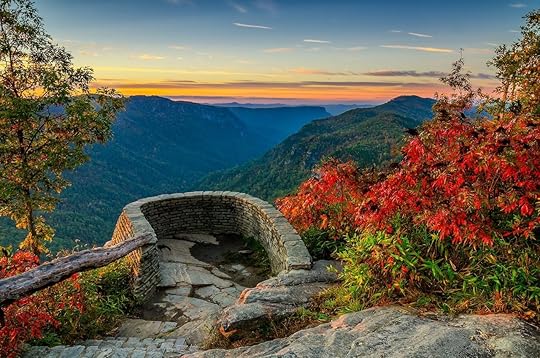
North Carolina is a state that has it all. Picturesque mountains and pristine beaches, drawing visitors during hot summers and (surprisingly) chilly winters. There’s plenty of variety to be found in North Carolina regardless of when you decide to plan your visit. Much can be seen on the road. Here’s how to plan the ultimate North Carolina road trip for outdoor adventure.
Start at Great Smoky Mountains National Park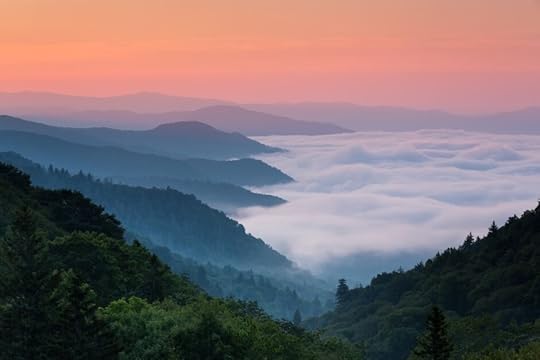
Photo: Keneva Photography/Shutterstock
The entrance to North Carolina begins in dramatic fashion at the most visited national park in the United States. Hike to the 6,644-foot top of Clingmans Dome, the highest natural point in the Smokies, and catch a sweeping view of the azure summits in North Carolina and across into Tennessee. The lofty peak straddles the border between the two states. Explore the eight hundred miles of green, dense mountain trails inside the park, or grab a tube, available from several nearby rental shops including Smoky Mountain River Adventures, for an idyllic ride enclosed among high elevation old-growth trees within the two thousand miles of streams and lakes.
If you have time for a second day in the park, drive into the remote Cataloochee Valley. Alongside the surrounding rugged landscape, keep your eyes peeled for wild elk grazing by the remnants of rustic log cabins from the late 19th century. Afterward, take a waterfall hike. The Deep Creek trail near Bryson City offers quick trips to the misty Tom Branch, Indian Creek, and Juney Whank Falls, or head just outside of the park towards Cherokee to find the majestic Mingo Falls, one of the tallest cascades in the southern Appalachians.
Cruise part of the Blue Ridge Parkway towards Mount Mitchell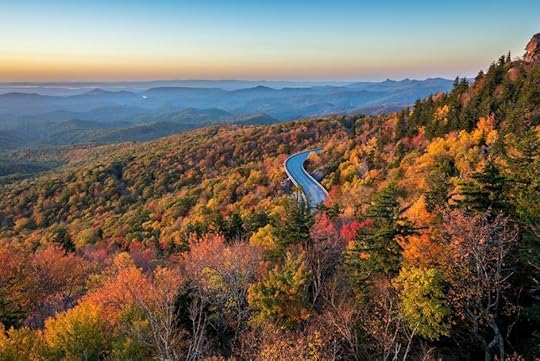
Photo: anthony heflin/Shutterstock
Connecting the entire mountain region of North Carolina from the Smokies to Virginia, the secluded and vibrant maple, chestnut, and oak-filled drive along the Blue Ridge Parkway departs from the park’s south entrance off of U.S. 421. This scenic drive is home to arguably the best views of fall foliage in the country. Since the elevation never rises above the treeline, sensational scenes of the reds, yellows, and orange hues of autumn can be found stretching for miles through the crisp air across the rolling summits. Make sure to grab a full tank of gas before entering, as stations are scarce along the parkway.
Turn off the Blue Ridge Parkway at NC 128, about an hour north of Asheville, to head into Mount Mitchell State Park. Drive to the lot near the top for a short walk to the summit, or climb the old-fashioned way up the lush but challenging 2.2 mile Old Mitchell Trail. Either way, you’lll be rewarded with 360-degree views of picturesque Blue Ridge Mountain scenery from the highest point east of the Mississippi River, extending for 85 miles on a clear dat. The summit is a stunning place to watch the sunset. The reds and pinks of dusk descend over the mountain horizon among the sweet scent of the numerous spruce and balsam firs, commonly grown in the region as Christmas trees, as your ear catches the songs of the ninety-one species of birds that call the state park home.
Where to stayNumerous campgrounds surround the peak. Camp inside the park at the Mt. Mitchell Campground or at the nearby Carolina Hemlocks Recreation Area. If you prefer an Airbnb, we recommend this charming mountain cabin outside of Asheville. Another option is this cabin for groups up to six.
We hope you love the spaces and stays we recommend! Just so you know, Matador may collect a small commission from the links on this page if you decide to book a stay. Listed prices are accurate as of the time of publication. See our full Advertiser Disclosure here.
See our full recommendations on the best Airbnbs in Asheville, North Carolina.
Head up to Linville GorgeContinue 20 miles northeast of Mount Mitchell to the town of Linville Falls, where neighboring trails to the eponymous roaring cascades can be found alongside several entry points to the towering Linville Gorge. Rising 1400 feet above the Linville River and twelve miles in length, a thronged thicket of birch, hickory, and hemlock flank the lush yet strenuous descent through Pisgah National Forest to the base of the gorge. Enjoy the coursing sounds of the river as you explore the high crags, a popular choice for all levels of rock climbing enthusiasts. For even more variety, try the mysterious Linville Caverns nearby. Hovering around a clammy fifty degrees in the interior, dress warmly if you choose to traverse the weathered stalactites of this bat-filled cave.
Visit Pilot Mountain and Hanging Rock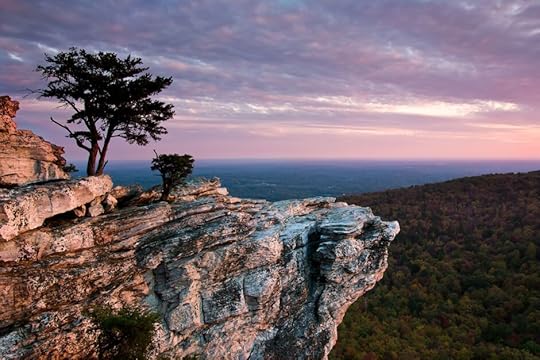
Photo: Greg Dollyhite/Shutterstock
Eighty-five miles northeast of Linville Gorge, the white quartzite walls defining the rounded knob of Pilot Mountain poke out above the rolling hills and woods of central North Carolina’s Piedmont (meaning “foot of the mountain” in French) region. One of the more recognizable attractions in the state, the iconic summit has been used as a navigational landmark for centuries. A short twenty miles away resides the coarse, chalky cliff edge of Hanging Rock State Park jutting out over an expansive view of the densely arboreal Sauratown Mountains. Hike the verdant, winding bike trails and dig your toes into the sands of the park’s forested lake for a rejuvenating swim amongst the scent of the pines.
For an Airbnb overnight, this beautiful retreat at the base of Pilot Mountain makes for a cozy stay. Another option is the iconic Pilot’s Peak Cabin, where you and up to six others in your crew can enjoy a warm and comfortable rest to the sound of the woods.
Cruise along the Eno River and down to Raven Rock State Park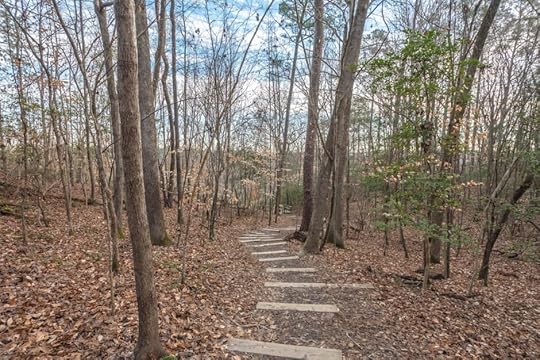
Photo: Chansak Joe/Shutterstock
Head seventy miles southeast just outside of Durham to find Eno River State Park. Consisting of numerous popular, shady swimming holes for residents of “The Triangle”, comprising Raleigh, Durham, and Chapel Hill, this richly timbered park offers locals a cool respite from the humid, sweltering heat of North Carolina summers. Dip into the inviting waters of Bobbitt’s and Sennett’s Holes, two of the river’s natural pools, or simply listen to the flow of the Eno and immerse yourself in the thick, canopied woods lining the many trails.
About twenty-five miles southwest of Raleigh and on the edge of North Carolina’s “fall line,” where waterfalls start to appear along creeks and streams, lies Raven Rock State Park. Try renting a kayak in nearby Lillington and take a daring journey over the roaring Lanier Falls and the fast-paced Fish Traps rapids. At the south end of the park, on top of the enormous, imposing grey walls of Raven Rock at the banks of the Cape Fear, enjoy a pastoral view of the clustered, viridian oaks and hickories lining the shores, or pack a lunch for a refreshing riverside picnic in the shade.
Raleigh and its surrounding area is rich in Airbnbs. Apex is both convenient and rich in dining options without having to drive all the way into the city. This townhome puts you right in the heart of the action. If you decide to stay in Raleigh, you’ll be approaching from the southwest. As such, we recommend this tidy apartment for easy access and comfort, and a warm shower after your time exploring outside.
Head to Green Swamp and Carolina BeachRoughly 80 miles around the port city of Wilmington is famously the only region in the entire world where the Venus flytrap can be found growing in the wild. Twenty-two miles east of town dwells the muggy 17,000 acres of the Green Swamp Preserve. Teeming with exotic plant life, hikers in the thick bog can find more insect-eating vegetation alongside the toothy emerald flytraps such as the lime-colored, lanky pitcher plant and the large, sticky pink leaves of the butterwort. Hop a ferry at Southport to Fort Fisher and head up the coast to Carolina Beach State Park, with miles of easy hikes among the bucolic longleaf pines and carnivorous flora, plentiful space for camping, or check out nearby Wilmington Jet Ski Rentals to explore the Cape Fear River in style.
Afterward, take US-17 north through North Carolina’s Inner Banks to find the lush, dewy Merchant’s Millpond and Dismal Swamp State Parks in the northeastern corner of the state. Bring a canoe or grab one from one of the rental stations conveniently located in both parks, and catch closeups of the lofty, bright jade bald cypress trees and swaying sage Spanish mosses poking out of the rich wetlands. Immerse yourself in the abundant greenery on one of the numerous boardwalk and mountain biking trails available, and watch for the brown otters, sleek bobcats, and the over two hundred species of colorful birds that inhabit the marshes.
See Jockey’s Ridge and cruise the Outer Banks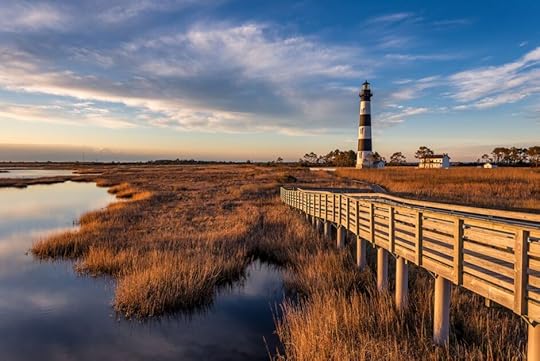
Photo: anthony heflin/Shutterstock
Roughly forty-five miles southeast of The Great Dismal Swamp lies the entrance to North Carolina’s famed Outer Banks, a series of picturesque barrier islands separating the mainland from the Atlantic Ocean. Hop on celebrated route NC-12 south past Kill Devil Hills to see the roaming yellow sands of Jockey’s Ridge State Park, the largest active dune system in the eastern United States. Resembling more a desert landscape than anything you’d expect to find on the east coast, it is not unusual to see a flurry of reds, blues, and blacks of kites lining the skies over the dog-friendly park. The windswept surrounding region, offering steady sea breezes and opportunities to perform and take lessons on the sports of kite flying and parasailing, is no stranger to aviation: a few short miles up NC-12 in Kitty Hawk is where the Wright Brothers flew the legendary first flight in 1903.
The Outer Banks is loaded with incredible places to stay. We break down the best budget Airbnbs in the Outer Banks and the most luxurious Airbnbs in the Outer Banks, respectively.
Your North Carolina road trip then takes you further south on NC-12 through the infamous “Graveyard Of The Atlantic.” Book a charter with Dive Hatteras and explore the sunken, haunting ruins of some of the nearly three thousand ghostly shipwrecks resting off the North Carolina coast. The southern end of Hatteras Island is home to the iconic black-and-white spirals of the tallest lighthouse in North America, Cape Hatteras Light, and plenty of options for camping near the ghost crab-filled shore in full sight of the towering beacon. Make sure to gaze at the night skies, as the faint, cloudy outline of the Milky Way is visible during low light conditions.
While NC-12 appears to end at Hatteras, the road actually continues over the water to Ocracoke Island via ferry. Free in the off-season, open to vehicles, and including a small onboard lounge offering comfortable views of the ocean, the hour-long journey through the calm seas is well worth it. Only accessible by boat, Ocracoke contains some of the most secluded beaches in the state. Grab a bite of fresh seafood from the laid-back town of Ocracoke and catch the fiery colors of the sun crossing the horizon alongside the soft roar of the waves, as this is one of the few places in the state where the sunset is observable across the Atlantic. Now far removed from the mainland, your North Carolina road trip concludes — you just have to make your way back to reality. 
Remote mountain cabins near NYC

Mountain elitists of the Western United States, with their Rocky Mountain and Sierra Nevada ranges, like to own the conversation about what qualifies as a “true mountain experience.” But New Yorkers are in on a secret: the pristine, forest-flanked alpine lakes of Adirondacks; the near-perfect undulations of White Mountains; and the steeps of the Green Mountains all hold their own when it comes to the perfect place to escape the urban madness. Any further proof they may need, as if there’s not already enough, is a snowshoe outing away from any of the cabins listed below. These mountain escapes are far enough away, about five hours from NYC, but within a day’s drive so as not to require an overnight en route — and they all make for an ideal getaway this winter.
We hope you love the spaces and stays we recommend! Just so you know, Matador may collect a small commission from the links on this page if you decide to book a stay. Listed prices are accurate as of the time of publication. See our full Advertiser Disclosure here.
1. Bull Crest Cabin, Elizabethtown, NY
Photo: Airbnb
$125/night via Airbnb
Drive time from NYC: under five hours
Cozy barely begins to describe the Bull Crest Cabin, high in the Adirondacks near Elizabethtown (and conveniently not too far from the slopes of Whiteface Mountain ski resort). This one comes with all the fixins, including a toasty fireplace. Full kitchen, full WiFi, and fully surrounded by forest, not a disturbance in the world to bother your crew other than the immediate access to a variety of outdoor activities like snowshoeing, skiing, or frigid forest bathing. The town itself isn’t far, either, in case a night out beckons or a trip to restock supplies is in order.
2. River Cabin w/ Sauna, Upper Jay, NY
Photo: Airbnb
$375/night via Airbnb
Drive time from NYC: under five hours
If you’ve ever wanted to know what it’s like to sauna inside a hollowed-out log, this property is your chance. The cabin itself is the bonus here, with the ability to sleep your entire crew of up to 12 people in four bedrooms within an 1800s guesthouse. The swank experience comes with a wood-burning stove, firepit, avocado chairs, and a river running nearby to wash away the sounds of the city. It’s less than half an hour from Whiteface Mountain and has walk-out hiking access so bring the snowshoes.
3. Unique and Rustic w/ Fireplace and Outdoor Space, Bartlett, NH
Photo: Airbnb
$195/night via Airbnb
Drive time from NYC: about six hours
Up to four guests can enjoy this cabin in the White Mountains outside of Bartlett, New Hampshire. Perfect for a snowshoe or ski getaway. Attitash Mountain resort is right up the road, with Cranmore and Black Mountain ski areas not far away. Back on property, enjoy an outdoor apres session around the fire pit or lounge in the spacious living room inside. The expansive kitchen and fireplace mean you can cook a meal and actually enjoy the process without feeling cramped. While there’s WiFi, phone service isn’t excellent here, making this cabin a good spot to head to disconnect from your electronics for a few days and get back to nature.
4. Pine Valley Cabins, Thornton, NH
Photo: Pine Valley Cabins/Facebook
$90/night
Distance from NYC: about five hours
Pine Valley Cabins are a collection of small cabins near Waterville Valley Resort and south of Loon Mountain. Each sleeps four people and offers easy access to the epicness that is northern New Hampshire. But despite all the skiing, snowshoeing, firepit story hours, and snowman building to be done on a trip here, one activity makes this a unique cabin getaway: snowmobiling. Bring the whole family out for a snowmobile adventure at the Corridor 11 Trail behind the property and several other established routes, where you can rip through powder lines and groomed tracks as part of the Twin Mountains Snowmobile Club. Call yourself a “sled head” or not, even riding on the back of one of these machines will have you hollering until it’s time for a Hot Toddy.
5. The Cabin, Mendon, VT
Photo: Airbnb
$375/night via Airbnb
Distance from NYC: about four-and-a-half hours
Get out of town and into the forest at this secluded cabin near the legendary Killington Ski Resort. The woodsy retreat is a welcome reprieve from the bustling ski resort and offers easy access to nature, which will likely beg you outside for a snowshoe, booted hike, or, at the very least, a cup of hot cocoa on the rustic wooden deck. The property is truly isolated from civilization but is modernized with a full kitchen, four bedrooms for six guests, and plenty of space to lounge. So if you’re the type who likes to escape to the woods to read or write you won’t find yourself in the dark out here.
6. Vermont Cabin with epic hot tub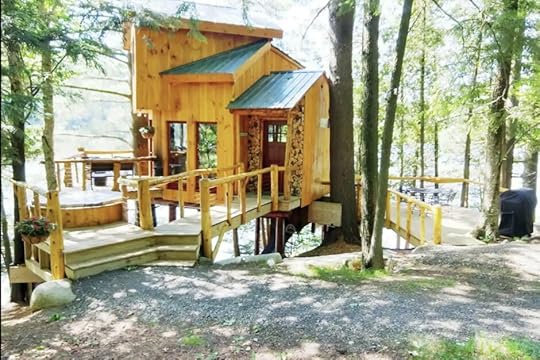
Photo: Airbnb
$186/night via Airbnb
Distance from NYC: about five-and-a-half hours
Part tree house, part mountain cabin — the total of the sum is that it doesn’t really matter because this secluded getaway spot has the most epic hot tub you’ve ever seen. Which is a good thing because nothing goes better with cold weather and a day in the mountains than a hot tub. It’s made of cedarwood and is perfect for you and your partner (or a very, very close friend). This so-called “treecabin” is a quick drive to Coventry and the surrounding recreational activities, but with this hot tub and its views out onto the Green Mountains, we wouldn’t blame you if you never left the elevated deck platform.
7. Secluded Luxury Cabin on Romantic Private Lake, Stanfordville, NY
Photo: Glamping Hub
$274/night via GlampingHub
Distance from NYC: about two hours
When the goal is mountain seclusion, the Catskills are an easy drive for massive reward. This high-end cabin embodies everything a vacation in the Borscht Belt should be — luxurious but remote, accessible yet quite affordable. Onsite you’ll find everything needed for a romantic getaway — a kitchen and porch grill for cooking inside or out, a spacious living area and outdoor lounge, and a bedroom with a view. Oh yeah, and the lake that’s yours to gaze upon as your wintertime fantasies manifest themselves. 
This animation gives new perspective on the deepest bodies of water in the world

The deepest bodies of water in the world can get pretty deep. So deep, in fact, that scientists estimate that 91 percent of ocean species have yet to be discovered, and more than 80 percent of the ocean is unexplored. That’s enough to make some people feel uneasy and avoid.
The exact depth (and how much we don’t know about what’s below the surface) depends on the body of water. A YouTube video from the 3D animators at MetaBallStudios, which is known for its size comparison videos, puts going down in the deep into new perspective. The video shows
But it can be challenging to discern between lakes, seas, and rivers. Instead of just comparing numbers, MetaBallStudios created a Youtube video that offers an easy-to-understand graphic of more than 40 measured points to show how low you can go.
The graphic is shaped like a hill starting at the Sea of Azov, which measures an average of about 23 feet, and ends at the Mariana Trench in the Pacific Ocean at just over 36,000 feet. The hill acts as a scaled model for a visual reference. It also uses physical references. For example, the RMS Lusitania, which was a catalyst for turning countries against Germany in World War I when it was torpedoed in 1915, is 305 feet down in the depths of the Northern Atlantic Ocean. To illustrate that, the video compares it to the Statue of Liberty, which is 305 feet tall.
In another comparison, the Eiffel Tower’s height of 1,063 feet is compared to the deepest scuba dive, which was done by Ahmed Gabr who went about 1,090 feet down. MetaBallStudios also threw in the tallest building in the world, the Burj Khalifa at 2,720 feet, for comparison to ocean depths. There are 28 depth points shown that go deeper than the Burj Khalifa is tall — including the more than 8,000 feet down the Perdido oil drill reaches in the Caribbean Ocean.
With this perspective in mind, it’s a little easier to see how so there’s so much below the surface of the water humans have let to learn about. 
Vaccinations you need to travel

Forget searching for dreamy Airbnbs, epic hiking routes, and culinary delicacies — the first thing you want to look up when planning a trip is all the vaccines you need to get. Sure, it’s a lot less fun than planning an itinerary, but it can make or break your trip, and it’s not something you can leave to the last minute. To make sure your travel plans don’t turn into a prolonged visit to the local hospital, we asked expedition and wilderness medicine specialist Dr. Andrew Peacock to give us all the info travelers need to know about vaccinations and travel.
Dr. Andrew Peacock has been practicing medicine for 20 years. He works as an emergency doctor in Australia six months out of the year and as a wilderness and expedition medicine specialist the rest of the time. (Plus, he’s a pretty great adventure travel photographer). His focus when working on guided trips in India, as a ship doctor on expeditions to Antarctica, or leading treks in Nepal is prevention and risk reduction, so he knows the importance of having your vaccines up to date.
General adviceMain vaccinations for travelersAre any of the recommended injections superfluous?Where can you get your vaccines done?Can vaccinations make you feel ill?When does a vaccine need to be done? How long does the protection last?Proof of vaccinationDiseases for which there is no vaccine, but for which travelers must be preparedExtra precautions travelers can take to remain healthyGeneral adviceAny US traveler considering a trip overseas must use two resources:
The Centers for Disease Control and Prevention (CDC) website. It is a very comprehensive and easy-to-understand platform with disease and country-specific details that for all types of travelers (long-term, short-term, pregnant, etc.). Dr. Peacock explains that doctors rarely recommend that patients check out the internet before consulting a doctor, but that the CDC website is an incredibly helpful resource that a traveler can trust.Their family physician. Volunteering three months in rural Uganda will not require the same medical advice as a two-day stay in Kampala, so a physician is the person travelers should turn to for their health-related needs in preparation for a trip.Dr. Peacock explains that the biggest mistake travelers can make regarding vaccinations is ignoring recommendations entirely. The price involved in getting several vaccinations before traveling is well worth the investment.
While it may suck to spend money on something you feel may not be needed, especially if you’re afraid of needles, it’ll cost you a lot more money in the long run if you end up getting sick while traveling and ruin your trip, so don’t skimp immunization — no matter the cost.
Main vaccinations for travelers1. Routine vaccinationsWhether you are traveling or staying home, the following routine vaccines are highly recommended for you and others to remain in good health:
Measles-mumps-rubella (MMR)Diphtheria-tetanus-pertussisVaricella (chickenpox)PolioNote that even though these vaccines are commonly called “routine,” they are not to be dismissed, especially by travelers. For example, there have been outbreaks of diphtheria in many countries around the world in the past few years — including Indonesia, Venezuela, and Myanmar — and several cases have been diagnosed in Australia. Diphtheria is a deadly disease that can be easily prevented thanks to vaccination.
If you’re not sure if you have been immunized for these diseases or if you think you are past the duration of protection, contact your family physician. They may have records of your past vaccinations if you don’t have a booklet to keep track.
2. Yellow feverYellow fever is a disease that is transmitted via the bite of an infected mosquito. Within three to six days, people infected with the yellow fever virus develop fever, chills, headache, joint and muscle pain, nausea, vomiting, abdominal and back pain, fatigue, and dehydration. In the most severe cases, the virus can lead to internal bleeding, organ failure, and the yellowing of the skin. Patients experiencing these serious symptoms will likely die within 10 to 14 days.
Yellow fever occurs in sub-Saharan Africa and tropical South America.

Photo: CDC
To avoid the international spread of this disease, some countries ask that all travelers show proof of yellow fever vaccination upon entering the country (Angola, Burundi, Central African Republic, Congo, Republic of the Côte d’Ivoire, Democratic Republic of Congo, French Guiana, Gabon, Ghana, Guinea-Bissau, Liberia, Mali, Niger, Sierra Leone, Suriname, Togo). Other countries require proof of vaccination only if travelers have been in a risk area. A full list updated in June 2018 is provided by World Health Organization here.
3. TyphoidTyphoid is a foodborne and waterborne disease. Within three weeks, people infected with typhoid will experience fever, headache, constipation or diarrhea, fatigue, and loss of appetite. In more severe cases, Typhoid can lead to the enlargement of the liver and spleen or intestinal bleeding and can be fatal.
According to CDC, “Typhoid is common in most parts of the world except in industrialized regions such as the United States, Canada, western Europe, Australia, and Japan.” The highest risk of typhoid for travelers is in South Asia although other areas of risk include Africa, Asia, the Caribbean, Central and South America. A good rule of thumb is that typhoid appears in countries where food and water sanitation is very poor.
The typhoid vaccine is only 50 percent to 80 percent effective, so you should be extremely careful of what you eat and drink when traveling to risk areas no matter what.
If you are afraid of needles, the typhoid vaccine can be taken orally in four doses by taking one capsule every other day for a week (day one, day three, day five, and day seven).
4. Hepatitis AHepatitis A is a foodborne and waterborne disease. It can also be transmitted from the hands of a person with hepatitis A and, rarely, through sexual contact. Within one to two weeks, people infected with Hepatitis A will experience sudden fever, tiredness, loss of appetite, nausea, vomiting, stomach pain, and yellowing of the skin and eyes.
Hepatitis A is found all over the world, except in Canada, western Europe and Scandinavia, Japan, New Zealand, and Australia. High-risk areas include countries with poor sanitary conditions and hygienic practices, such as parts of Africa and Asia.
The vaccine is nearly 100 percent effective and requires two doses injected six months apart.
5. Hepatitis BHepatitis B is a contagious virus transmitted via blood, blood products, and other bodily fluids. People infected with the Hepatitis B virus develop a sudden fever, tiredness, loss of appetite, nausea, vomiting, stomach pain, dark urine, joint pain, and yellowing of the skin and eyes. Some people infected with the virus develop lifelong, chronic Hepatitis B. This can cause people to die early from liver disease and liver cancer.
Countries with a prevalence of Hepatitis B infection:

Photo: CDC
The vaccine is over 90 percent effective and is a three-dose immunization; the second vaccine is given one month after the first dose, and the third dose is given six months after the first dose.
6. CholeraCholera is a severe intestinal infection caused by the ingestion of food and/or water contaminated with the cholera bacteria. People infected produce large amounts of watery diarrhea. The lost of fluid can be fatal, but drinking safe water to replace the lost fluids dramatically lowers the risk of death.
Travelers are rarely at risk of cholera unless they remain in high-risk areas for a long time and consume unsafe food and water. Travelers who volunteer in refugee camps or in disaster relief in the countries listed below have a higher risk of infection.
Cholera is present in Angola, Burundi, Chad, the Democratic Republic of the Congo, Ethiopia, Kenya, Malawi, Mozambique, Nigeria, Somalia, South Sudan, Tanzania, Uganda, Zambia, Zimbabwe, Bangladesh, India, Yemen and Haiti.
The cholera vaccine is to be taken orally in a single dose at least 10 days before exposure to the bacteria.
7. RabiesRabies is transmitted through the saliva of a rabid animal (dogs, bats, monkeys, foxes, mongoose, raccoons, etc.). Humans usually get rabies after being licked, bitten, or scratched by an infected animal. Rabies affects the central nervous system, causing brain disease and death.
Rabies is found around the world except in Antarctica; however, risks are heightened in much of Africa, Asia, and Central and South America.
Prevention is key for the rabies virus because once the symptoms appear, the disease is almost always fatal. The rabies vaccine is a is three-shot series (days zero, seven, and 21 or 28) given at least one month before travel.
Whether you have been vaccinated against rabies or not, if you get bitten, licked, or scratched by an animal in a high-risk area, you should seek immediate treatment.
The best way to prevent rabies is not to approach animals, especially in high-risk areas. Symptoms of rabid animals are not always obvious, so remain extremely careful.
8. Japanese encephalitisJapanese encephalitis is a disease transmitted by mosquito bites. Symptoms such as fever, headache, vomiting, confusion, and difficulty moving appear within five to 15 days. Japanese encephalitis can be fatal, and there is no treatment.
For most travelers to Asia, the risk of being infected by Japanese encephalitis is extremely low, but it varies based on destination, duration, season, and activities. Travelers who stay in rural areas for several months and spend a lot of time outdoors are the most at risk. The CDC explains that “in mild climates in northern Asia the risk for Japanese encephalitis is greater in the summer and fall. In tropical and subtropical areas, there is a risk year-round”.

Photo: CDC
The Japanese encephalitis vaccine must be done at least six weeks before your departure. The immunization is done in two doses administered a month apart.
9. Meningococcal DiseaseMeningococcal Disease is transmitted from person to person through droplets of respiratory or throat secretions. Kissing, sneezing, or coughing on someone, or sharing accommodations with an infected person facilitates the transmission. Symptoms include a stiff neck, high fever, sensitivity to light, confusion, headaches, and vomiting. Five percent to ten percent of patients die, typically within 24 to 48 hours after the start of symptoms.
Only those traveling long term to the meningitis belt in sub-Saharan Africa during the dry season (December through June) are at at risk and need to be vaccinated.

Photo: CDC
Note that Saudi Arabia requires participants in the Hajj and Umrah pilgrimage to show proof of meningococcal vaccination.
It takes seven to 10 days after the injection for the vaccine to be fully effective.
Are any of the recommended injections superfluous?Dr. Peacock explains that “before immunization, travelers must research about the diseases occurring in the countries they will be visiting and check if their travel plans put them at risk.” Only then can they make a serious decision about getting vaccinated.
Here is an example to illustrate the need for travelers to gather information before being vaccinated:
CDC recommends that some travelers to Madagascar get immunized against Hepatitis B. Hepatitis B is a contagious virus that is passed on through sexual contact, contaminated needles, and blood products. CDC recommends this vaccine if you might have sex with a new partner, get a tattoo or piercing, or have any medical procedures. If you don’t plan on doing any of the above while in Madagascar, you can argue that you needn’t be immunized. But Dr. Peacock explains that you never know when an emergency situation will require that you undergo a medical procedure that can lead to Hepatitis B contamination.
Where can you get your vaccinations done?There are several locations where you can get your immunizations done. Some of the items on the list below will lead you to official websites that will allow you to find a place near you to get your vaccinations done.
Family physician’s officeLocal Health CenterState and local Health DepartmentTravel clinicsTravelers’ health-specialized physiciansYellow fever vaccination clinicsLocal Pharmacies. Not all pharmacists are authorized to administer vaccinations, but it is worth asking your local pharmacist if your options are limited.Can vaccinations make you feel ill?It is not uncommon to get a localized reaction at the injection site (redness, irritation, swelling, bruising, etc.), but serious side effects are very rare. Keep in mind that the risks from the diseases vaccines prevent are much greater than the risk of vaccines’ side effects.
When does a vaccine need to be done? How long does the protection last?The earlier, the better. Dr. Peacock recommends that you check out the CDC website and make an appointment with your physician as soon as you know when and where you are going, “even if your departure date is six months away.” The reasons behind the urgency are as follows:
A vaccine asks your immune system to respond to the antigens injected by developing antibodies. But creating this defense does not happen overnight, so if you get your vaccines done only a week before you’re setting off, you may not be fully protected.Certain vaccines require several injections, a few months apart. For example:– Hepatitis A requires two doses injected six months apart to be as effective as possible.– Hepatitis B is a three-dose vaccine. The second vaccine is given 1 month after the first dose and the third dose is given six months after the first dose.– Rabies is three-shot series (days zero, seven, and 21 or 28) given at least one month before travel.Proof of yellow fever vaccine is only valid 10 days after the injection.The duration of protection is vaccine-specific. Yellow fever is supposed to last a lifetime, but doctors recommend that you get a booster shot after 10 years. For typhoid, a booster shot is needed after two years. Do not assume that you are still protected against a disease if you were vaccinated against it a long time ago. Visit your physician to get a booster shot to make sure you are safe before traveling and ask them for a booklet where you can keep track of your vaccinations needs.
Proof of vaccination
Photo: Henrik Dolle/Shutterstock
Before you make an appointment to get immunized, try to locate your vaccination records (baby book, family physician, etc.). It will be very helpful for the physician to know what vaccinations you need. Also, make sure to ask the person administering your vaccines for a booklet where your vaccines and the dates of injections are listed. If you already have one, provide it so it gets updated.
Certain countries require proof of yellow fever vaccination. Upon immunization, you should receive a yellow card called the
International Certificate of Vaccination or Prophylaxis (ICVP) to prove that you have had yellow fever vaccine. Note that the proof is only valid 10 days after the injection.
Dr. Peacock recommends that you bring your vaccination booklets with you, even if no proof of vaccination is necessary at your destination. The precaution can be very helpful in case of an emergency situation abroad.
Diseases for which there is no vaccine but travelers must be preparedThe two most common travel diseases for which there is no vaccination are:
1. MalariaOn October 6, 2021, The World Health Organization approved a malaria vaccine called RTS,S/A01. The vaccine targets the most deadly and most common type of malaria in Africa: Plasmodium falciparum. It will first be rolled out to children in sub-saharan Africa.
Until the malaria vaccine is more widely available, there are several prescription medicines available to travelers who will visit countries at risk. Dr. Peacock states that not all malaria medication provokes unpleasant side effects as seems to be the rumor among travelers worldwide. There are a few options out there, and your doctor will help you navigate them according to your needs. Anti-malaria medication needs to be taken before, during, and after your trip, so, just like with vaccines, do not wait until the last minute to consult your physician about your travel health. Note that since malaria is a disease transmitted through mosquitoes, travelers should prevent mosquito bites by using repellent; covering their skin with long sleeves, long pants, and hats; using mosquito nets and staying in screened accommodations; staying indoors when mosquitoes are the most active, and using permethrin-treated clothing and gear.

Photo: CDC
2. Infectious diarrheaInfectious diarrhea is a foodborne and/or waterborne infection. Travelers can do their best to prevent it by making sure the water they drink is boiled or treated and the food they eat is cooked and prepared with proper hygiene. According to Dr. Peacock, “Usually, infectious diarrhea resolve itself in four to five days, but can make you feel quite miserable.” There are antibiotics available that can treat the infection, so ask your physician about them before you set off. Note that Imodium does not treat the infection but will reduce the frequency of your stool in an effort to help control the symptoms. Do not take Imodium unless you need to (long bus rides, long flights, etc.) as it may prolong the problem.
Dengue, zika, and schistosomiasis, among others, are also diseases that currently cannot be prevented by vaccines. Travelers going to infected areas should look into the best behavior to adopt so as to remain safe. Consult the CDC’s list of diseases that can affect travelers here.
Extra precautions travelers can take to remain healthyPrevent bug bites by:Using repellentWearing long sleeves, long pants, and hatsUsing mosquito nets around your bed and stay in screened accommodationsStaying indoor when mosquitoes are the most active at your destinationUsing permethrin-treated clothing and gearAvoid your exposure to germs by:Avoiding close contacts with infected people (kissing, hugging, etc.)Not sharing food or drinks with othersWashing your hand with soap or using hand sanitizerNot touching your eyes, nose, and mouth with your handsEat and drink safely by:Boiling or treating water before drinking, or drinking from sealed bottles onlyEating fully-cooked and hot food from places with reputable hygienic practicesEating only fruits and vegetables that you can wash and peel yourself (if it’s washed with contaminated water, you will get sick)Eating and drinking only pasteurized dairy productsAvoiding street food, if sanitation conditions are in questionPutting ice in your drinks (ice made with contaminated water will get you sick)Avoid sharing body fluids by: Using condoms or refraining from having sexual intercourseNot sharing food or drinks with othersAvoiding tattoos, piercings, and acupunctureAvoid non-sterile medical or cosmetic equipment by:Avoiding frequenting spas or beauty salons that seem unhygienicAvoiding tattoos, piercings, and unnecessary medical proceduresKeep away from wild or stray animals
A version of this article was previously published on August 13, 2018, and was updated on October 7, 2021, with more information.
More like thisCOVID-19The case for, and against, a vaccination passportCelebrate Queer Christmas at the best LGBTQ Halloween events in the US

When it comes to Queer Christmasfor all-things LGBTQ, and this year’s best Halloween events are lurking right around the corner.
A queer take on HalloweenWhile the origins of Halloween involve a mix of ancient Celtic rituals and pagan customs, the queer roots of this autumnal tradition reach back to Drag Balls held in cities like New York and Chicago starting in the 1920s. Queer communities hosted many of these Halloween events, a holiday used to protect men and women dressed as the opposite gender from inspiring raised eyebrows.
In the 1950s and 1960s, San Francisco’s Halloween became a chance for drag queens to walk the streets with impunity. Wearing clothes that didn’t match your sex was illegal until 1974, but on All Hallow’s Eve, all bets were off. In The Mayor of Castro Street: The Life and Times of Harvey Milk (1982), author Randy Shilts writes that “One evening a year, like a chapter from a Cinderella story, the police would bestow a free night upon the homosexuals.” That evening was October 31 — the queer equivalent of a Christmas miracle.
While the original Celtic holiday imagined a veil lifting between the real world and spiritual world, San Francisco’s interpretation saw the veil lift between the closeted self and the queer self.
As the city’s celebration grew in popularity, similar holiday festivals sprang up in gayborhoods around the nation. NYC’s Greenwich Village began hosting a Halloween parade in 1973. LA’s West Hollywood threw their first shindig in 1987. Wilton Manors, Florida’s prominent LGBTQ enclave, started throwing an annual Halloween bash in 2007 that rivaled anything else in the state, aside from Key West, where queer folks celebrate the holy day for an entire week.
Today, Halloween continues to be a gifted night of freedom, where LGBTQ people can flirt with self-presentation without worrying about social repercussions. “So many queens on RuPaul’s Drag Race say their first time doing drag was on Halloween,” notes Brad Balof, the chair for Northalsted’s Halloween committee in Chicago. Halloween isn’t only a holiday for celebration — it’s an opportunity for exploration.
“I like that there’s a lot of different versions of Halloween,” says Benjamin Nicholls, executive director of the Hillcrest Business Association, which presides over San Diego’s annual LGBTQ-centered Halloween block party. “You can make this holiday whatever you want it to be. If you want to make it gory and gross, you can. If you want to make it fun, you can do that, too.”
Luckily, the US is filled with welcoming Halloween happenings that encourage people to come out of the closet as whoever or whatever they want to be. Trick-or-treat your way to one of these American cities this October to celebrate the most wonderful time to be queer.
New York CityIf you’re looking to sin in the city that doesn’t sleep, Halloween will spoil you for choice. Queer Brooklyn clubs like 3 Dollar Bill and House of Yes serve up Halloween-themed parties throughout the month. On October 29th, Susan Bartsch’s bewitchingly queer cabaret will put a spell on audiences with Bartchsland’s Halloween Extravaganza. On October 30 and 31, gay pop-up parties like Horse Meat Disco and Battle Hymn plan on tempting LGBTQ club kids to twirl till the bewitching hour along with scores of other events throughout the city.

Photo: House of YesFacebook
For NYC’s main event, head to the Village Halloween Parade, which isn’t specifically queer-focused but still feels like an anything-goes extension of June’s Pride celebrations. This year, gay comedian Randy Rainbow serves as Grand Marshal and will lead thousands of whimsically dressed revelers along 6th Avenue from Spring Street to 16th Street. Once the parade ends, nearby LGBTQ bars in the West Village and Chelsea usually flood with foot traffic from the event.

Photo: nychalloweenFacebook
But Halloween in Gotham City isn’t only about dressing up and dancing til dawn. On October 21, pay respects to New York’s queer past by joining Gay Bars That Are Gone, a walking tour that visits LGBTQ landmarks laid to rest in Manhattan.
“Gay Bars That Are Gone is a memory walk,” says Michael Ryan, the tour’s creator. “It’s about honoring and actively remembering histories that so often don’t get included in textbooks. From the 1850s to beloved bars that closed during the pandemic, we are raising spirits.”
You won’t need a costume for this studious seance, but Michael recommends attendees bring money. Post-tour, guests usually gather for a drink at Julius’ — a blast-from-the-past gay bar that only takes cash.
San DiegoEvery year, Hillcrest gets weird for Nightmare on Normal Street, a queer block party benefiting the San Diego LGBT Community Center. The outdoor fest is like a raucous carnival: food trucks line the streets, local DJs spin tunes, and guests can participate in a runway-style costume competition with a $2,000 grand prize.

Photo: Fabulous HillcrestFacebook
After canceling last year’s event, the city’s gayborhood is ready to bring back their ghouls with this year’s theme, Nightmare Prom. “I’m really excited about seeing the costumes,” says Benjamin Nicholls, though he notes that folks shouldn’t worry if they don’t have something to wear. With face painters on-site and glow sticks for sale, you can get into the Halloween spirit after you arrive. Guests can capture their looks on camera in an immersive, selfie-friendly area of the festival decorated like a haunted high school. It’ll be like Carrie, minus the demonic teenagers — this is a 21-and-up event with free drinks for the party’s first hour.
Nightmare on Normal Street takes place on Friday, October 29, from 2:00 PM — 11:00 PM, but the party doesn’t end once the nightmare is over. Hillcrest’s abundance of gay bars are the de-facto afterparty destinations, so stop by spots like Rich’s, Gossip Grill, or the Rail to keep the night alive.

Photo: Rich’sFacebook
“My number one piece of advice is to plan ahead,” says Nicholls. “Our ticket sales are off the hook right now, and bars are going to be packed. People waiting for the last minute to buy tickets will struggle to find a place at the bar.”
ProvincetownProvincetown is best known for its queer summer bacchanalias, but every Halloween, the tip of Cape Cod resurrects the ghosts of seasons past for a weekend of frightening frivolity along Commercial Street. Although the ghoulish gathering is dubbed Spooky Bear Weekend and hosted by the Northeast Ursamen (a bear-centric LGBTQ club), wild animals of all kinds are welcome to join the festivities.
This year’s official events kick off on Friday, October 29, with a meet-and-greet and ghost tour around town. Saturday continues with midday trivia, a sunset dune tour, and the Northeast Ursamen’s costume ball and contest at Crown and Anchor. Expect to see a circus of furry Jessica Lange impersonators — this year’s theme is American Hairy Story.
Participating in these events isn’t the only way to enjoy Halloween in P-town. “I love walking down Commercial Street and seeing the epic costumes,” says Dave Greenberg, President of Northeast Ursamen. “I know there are massive Halloween parties that take place all over the country, but to see all the creativity here — especially on Saturday afternoon — is one of my favorite things.” He also recommends going to the Boatslip’s afternoon Tea Dance and bar hopping to spots like A-House, one of America’s oldest gay bars, to make the most of the evening.
If you’re looking to spend the weekend, book your lodging now. Hotels are pricey and fill up faster than a pet cemetery in a Stephen King novel. For an extra-spooky stay, check-in at the Carpe Diem Guesthouse — a charming bed and breakfast with a chilling backstory. The building served as Provincetown’s funeral parlor in the 19th century, and legend says that some guests got such a good night’s rest, they decided to become permanent residents. After a wicked weekend in this queer mecca, you might choose to do the same.
AtlantaIf the usual panoply of dance parties and parades aren’t your kinds of witchcraft, run amock to Atlanta’s Plaza Theater — the city’s oldest operating cinema — for two separate nights of queer Halloween classics. Wussy, the Big Peach’s queer pop-culture coven, is bringing the 1990s back to life with screenings of The Craft (October 13) and Hocus Pocus (October 27). Expect Rocky Horror vibes for both viewings: guests are encouraged to don their most daring looks and interact with the films.

Photo: Plaza AtlantaFacebook
Whether you go total teen psycho like Fairuza Balk or slip on your best Sanderson sister drag, you’ll have plenty of queer company. The events will be hosted by local drag queens, including Dotte Com and Molly Rimswell. Prizes will be awarded to the best-dressed guests.
ChicagoEvery October, Chicago’s Northalsted (formerly known as Boystown) dons its best Halloween drag for Haunted Halsted — a week-long celebration culminating in a parade and festival featuring a cash-prize costume contest.
“I love being able to see everybody’s creativity,” says Brad Balof, a Northalsted Business Alliance board member and chair of the Halloween committee. “People look really different when they use their creativity to express themselves through their costumes, and it creates a diverse atmosphere.”
Although the Halloween festivities occur in the city’s historic gayborhood, Balof says people of all ages and orientations participate in the parade. A couple of his favorite past costumes include a family dressed as characters from Tim Burton movies and a group of nine men dancing in inflatable dinosaur outfits.
Balof, who also manages the monster-sized gay bar Sidetrack, recommends visitors see as many costume contests at local clubs as possible. “If you’re coming with an elaborate costume, there are lots of prizes to be won,” he notes.
When it comes to the holy day, Chicago’s gayborhood is dead serious. “This is the only parade in the city that happens on Halloween night, whenever Halloween falls,” says Balof.
Events begin on October 23 and include everything from a puppy crawl walk to a family fun zone. The annual parade kicks off on October 31 at 6:00 PM.
New OrleansIn the land of voodoo queens and homoerotic vampire tales, Halloween is more than a holiday — it’s a way of life. It’s no wonder, then, that New Orleans’ queer community celebrates All Hallow’s Eve all weekend long. The flashiest of these events is hosted by Halloween New Orleans (HNO), an LGBTQ-centric non-profit established in 1983 to raise money for Project Lazarus — a community center for people living with HIV/AIDS. “Halloween New Orleans is one of the last circuit parties that’s still a fundraiser; 100 percent of the proceeds go to charity,” says Joe Gauthreaux, a New Orleans-born DJ who will spin during the party’s main event on October 30.

Photo: Halloween New Orleans
Although some of the group’s annual festivities, including the high-profile Lazarus Ball (pictured above), are canceled this year due to COVID-19, you can still party with a purpose at HNO’s arcade-themed dance party and costume contest on Saturday. A Sunday tea dance and costume awards competition follows suit.
While shindigs and costume contests might be par for the paranormal course, HNO stands out from the rest of America’s LGBTQ Halloween festivals thanks to its post-tea dance tradition: a second line through the French Quarter. This classic New Orleans happening is a joyous procession that usually takes place after funerals. Rather than mourn death, a second line chooses to celebrate life — an apt homage to the origins of Queer Christmas. 
The post Celebrate Queer Christmas at the best LGBTQ Halloween events in the US appeared first on Matador Network.
Matador Network's Blog
- Matador Network's profile
- 6 followers



